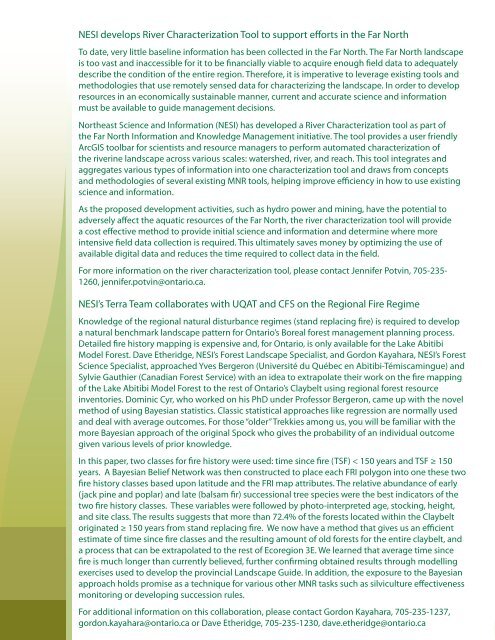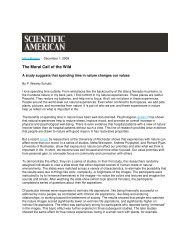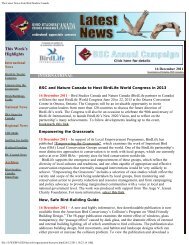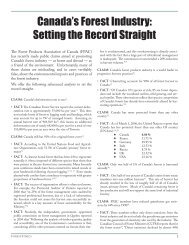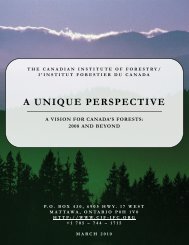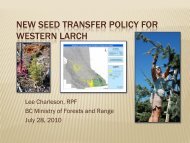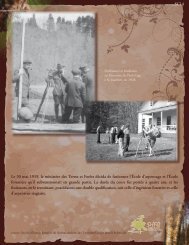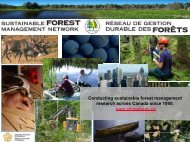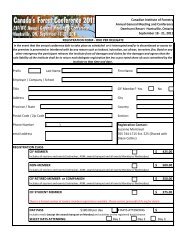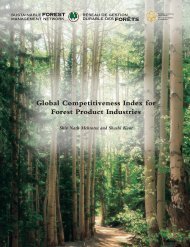SIB Tech Rept Template - Canadian Institute of Forestry
SIB Tech Rept Template - Canadian Institute of Forestry
SIB Tech Rept Template - Canadian Institute of Forestry
- No tags were found...
Create successful ePaper yourself
Turn your PDF publications into a flip-book with our unique Google optimized e-Paper software.
NESI develops River Characterization Tool to support efforts in the Far North<br />
To date, very little baseline information has been collected in the Far North. The Far North landscape<br />
is too vast and inaccessible for it to be financially viable to acquire enough field data to adequately<br />
describe the condition <strong>of</strong> the entire region. Therefore, it is imperative to leverage existing tools and<br />
methodologies that use remotely sensed data for characterizing the landscape. In order to develop<br />
resources in an economically sustainable manner, current and accurate science and information<br />
must be available to guide management decisions.<br />
Northeast Science and Information (NESI) has developed a River Characterization tool as part <strong>of</strong><br />
the Far North Information and Knowledge Management initiative. The tool provides a user friendly<br />
ArcGIS toolbar for scientists and resource managers to perform automated characterization <strong>of</strong><br />
the riverine landscape across various scales: watershed, river, and reach. This tool integrates and<br />
aggregates various types <strong>of</strong> information into one characterization tool and draws from concepts<br />
and methodologies <strong>of</strong> several existing MNR tools, helping improve efficiency in how to use existing<br />
science and information.<br />
As the proposed development activities, such as hydro power and mining, have the potential to<br />
adversely affect the aquatic resources <strong>of</strong> the Far North, the river characterization tool will provide<br />
a cost effective method to provide initial science and information and determine where more<br />
intensive field data collection is required. This ultimately saves money by optimizing the use <strong>of</strong><br />
available digital data and reduces the time required to collect data in the field.<br />
For more information on the river characterization tool, please contact Jennifer Potvin, 705-235-<br />
1260, jennifer.potvin@ontario.ca.<br />
NESI’s Terra Team collaborates with UQAT and CFS on the Regional Fire Regime<br />
Knowledge <strong>of</strong> the regional natural disturbance regimes (stand replacing fire) is required to develop<br />
a natural benchmark landscape pattern for Ontario’s Boreal forest management planning process.<br />
Detailed fire history mapping is expensive and, for Ontario, is only available for the Lake Abitibi<br />
Model Forest. Dave Etheridge, NESI’s Forest Landscape Specialist, and Gordon Kayahara, NESI’s Forest<br />
Science Specialist, approached Yves Bergeron (Université du Québec en Abitibi-Témiscamingue) and<br />
Sylvie Gauthier (<strong>Canadian</strong> Forest Service) with an idea to extrapolate their work on the fire mapping<br />
<strong>of</strong> the Lake Abitibi Model Forest to the rest <strong>of</strong> Ontario’s Claybelt using regional forest resource<br />
inventories. Dominic Cyr, who worked on his PhD under Pr<strong>of</strong>essor Bergeron, came up with the novel<br />
method <strong>of</strong> using Bayesian statistics. Classic statistical approaches like regression are normally used<br />
and deal with average outcomes. For those “older” Trekkies among us, you will be familiar with the<br />
more Bayesian approach <strong>of</strong> the original Spock who gives the probability <strong>of</strong> an individual outcome<br />
given various levels <strong>of</strong> prior knowledge.<br />
In this paper, two classes for fire history were used: time since fire (TSF) < 150 years and TSF ≥ 150<br />
years. A Bayesian Belief Network was then constructed to place each FRI polygon into one these two<br />
fire history classes based upon latitude and the FRI map attributes. The relative abundance <strong>of</strong> early<br />
(jack pine and poplar) and late (balsam fir) successional tree species were the best indicators <strong>of</strong> the<br />
two fire history classes. These variables were followed by photo-interpreted age, stocking, height,<br />
and site class. The results suggests that more than 72.4% <strong>of</strong> the forests located within the Claybelt<br />
originated ≥ 150 years from stand replacing fire. We now have a method that gives us an efficient<br />
estimate <strong>of</strong> time since fire classes and the resulting amount <strong>of</strong> old forests for the entire claybelt, and<br />
a process that can be extrapolated to the rest <strong>of</strong> Ecoregion 3E. We learned that average time since<br />
fire is much longer than currently believed, further confirming obtained results through modelling<br />
exercises used to develop the provincial Landscape Guide. In addition, the exposure to the Bayesian<br />
approach holds promise as a technique for various other MNR tasks such as silviculture effectiveness<br />
monitoring or developing succession rules.<br />
For additional information on this collaboration, please contact Gordon Kayahara, 705-235-1237,<br />
gordon.kayahara@ontario.ca or Dave Etheridge, 705-235-1230, dave.etheridge@ontario.ca


